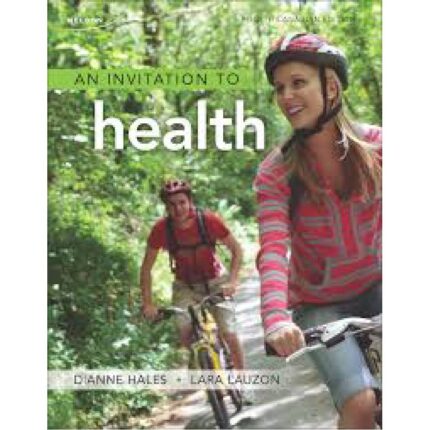Invitation To Health 17th Edition by Hales – Test Bank
True / False
1. All STI pathogens hate light, cold, and dryness.
a. True
b. False
ANSWER: True
REFERENCES: Sexually Transmitted Infections and Diseases
LEARNING OBJECTIVES: INHB.HALE.17.11.1 – Outline the characteristics and risk factors of sexually transmitted infections and diseases.
KEYWORDS: Bloom’s: Understand
2. For those who abstain from vaginal or anal intercourse, other sexual activity (e.g., oral sex) can expose them to STIs.
a. True
b. False
ANSWER: True
REFERENCES: The ABCs of Safer Sex
LEARNING OBJECTIVES: INHB.HALE.17.11.2 – Explain the factors that lead to a healthy sexual life.
KEYWORDS: Bloom’s: Remember
3. Almost nine in ten undergraduates are sexually active, and the majority use condoms during vaginal intercourse.
a. True
b. False
ANSWER: False
REFERENCES: STIs on Campus
LEARNING OBJECTIVES: INHB.HALE.17.11.3 – Summarize the risk factors related to sexually transmitted infections among college students
KEYWORDS: Bloom’s: Remember
4. Men and women share similar risks for developing STIs.
a. True
b. False
ANSWER: False
REFERENCES: The ABCs of Safer Sex
LEARNING OBJECTIVES: INHB.HALE.17.11.2 – Explain the factors that lead to a healthy sexual life.
KEYWORDS: Bloom’s: Understand
5. Most people who become infected with human papillomavirus (HPV) do not have any symptoms, and the infection clears on its own
a. True
b. False
ANSWER: True
REFERENCES: Common STIs and STDs
LEARNING OBJECTIVES: INHB.HALE.17.11.4 – Discuss the nature, incidence, signs and symptoms, and preventive measures and treatments of common sexually transmitted diseases.
KEYWORDS: Bloom’s: Understand
6. About one in five men and one in nine women have genital herpes.
a. True
b. False
ANSWER: False
REFERENCES: Common STIs and STDs
LEARNING OBJECTIVES: : INHB.HALE.17.11.4 – Discuss the nature, incidence, signs and symptoms, and preventive measures and treatments of common sexually transmitted diseases.
KEYWORDS: Bloom’s: Remember
7. In men, untreated gonorrhea can spread to the prostate gland, testicles, bladder, and kidneys.
a. True
b. False
ANSWER: True
REFERENCES: Common STIs and STDs
LEARNING OBJECTIVES: INHB.HALE.17.11.4 – Discuss the nature, incidence, signs and symptoms, and preventive measures and treatments of common sexually transmitted diseases.
KEYWORDS: Bloom’s: Remember
8. The first sign of syphilis is a skin rash.
a. True
b. False
ANSWER: False
REFERENCES: Common STIs and STDs
LEARNING OBJECTIVES: INHB.HALE.17.11.4 – Discuss the nature, incidence, signs and symptoms, and preventive measures and treatments of common sexually transmitted diseases.
KEYWORDS: Bloom’s: Understand
9. Trichomoniasis is the most common vaginal infection in women ages 15 to 44.
a. True
b. False
ANSWER: False
REFERENCES: Common STIs and STDs
LEARNING OBJECTIVES: INHB.HALE.17.11.4 – Discuss the nature, incidence, signs and symptoms, and preventive measures and treatments of common sexually transmitted diseases.
KEYWORDS: Bloom’s: Remember
10. HIV infection is associated with a variety of HIV-related diseases, including various cancers and dangerous infections such as tuberculosis.
a. True
b. False
ANSWER: True
REFERENCES: Common STIs and STDs
LEARNING OBJECTIVES: INHB.HALE.17.11.4 – Discuss the nature, incidence, signs and symptoms, and preventive measures and treatments of common sexually transmitted diseases.
KEYWORDS: Bloom’s: Understand
Multiple Choice
11. Which slang term is a reference to public lice?
a. “scabs”
b. “the clap”
c. “cankers”
d. “shankers”
e. “crabs”
ANSWER: e
REFERENCES: Common STIs and STDs
LEARNING OBJECTIVES: INHB.HALE.17.11.4 – Discuss the nature, incidence, signs and symptoms, and preventive measures and treatments of common sexually transmitted diseases.
KEYWORDS: Bloom’s: Remember
12. Marlene has an outbreak of painful red bumps on her mouth. She may have contracted which STI?
a. gonorrhea
b. herpes simplex
c. HIV/AIDS
d. syphilis
e. chlamydia
ANSWER: b
REFERENCES: Sexually Transmitted Infections and Diseases
LEARNING OBJECTIVES: INHB.HALE.17.11.1 – Outline the characteristics and risk factors of sexually transmitted infections and diseases.
KEYWORDS: Bloom’s: Apply
13. Kaposi’s sarcoma is best identified as a ____.
a. secondary cancer associated with AIDS
b. complication of HPV infection
c. secondary infection associated with syphilis
d. sexually transmitted bacterial infection
e. mild, self-limiting viral infection
ANSWER: a
REFERENCES: Common STIs and STDs
LEARNING OBJECTIVES: INHB.HALE.17.11.4 – Discuss the nature, incidence, signs and symptoms, and preventive measures and treatments of common sexually transmitted diseases.
KEYWORDS: Bloom’s: Understand
14. A chancroid is best described as a sexually transmitted ____.
a. disease
b. agent
c. infection
d. bacteria
e. virus
ANSWER: c
REFERENCES: Sexually Transmitted Infections and Diseases
LEARNING OBJECTIVES: INHB.HALE.17.11.1 – Outline the characteristics and risk factors of sexually transmitted infections and diseases.
KEYWORDS: Bloom’s: Understand
15. Typically, STIs are spread via ____.
a. casual contact
b. expectoration
c. needles
d. body fluids
e. fecal discharge
ANSWER: d
REFERENCES: Sexually Transmitted Infections and Diseases
LEARNING OBJECTIVES: INHB.HALE.17.11.1 – Outline the characteristics and risk factors of sexually transmitted infections and diseases.
KEYWORDS: Bloom’s: Remember













Reviews
There are no reviews yet.